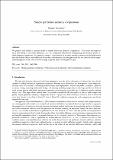Files in this item
Simple preference intensity comparisons
Item metadata
| dc.contributor.author | Gerasimou, Georgios | |
| dc.date.accessioned | 2022-07-14T23:35:34Z | |
| dc.date.available | 2022-07-14T23:35:34Z | |
| dc.date.issued | 2021-03 | |
| dc.identifier | 272333007 | |
| dc.identifier | 5d888c07-08a3-4188-91e7-e7f155558a76 | |
| dc.identifier | 85099633089 | |
| dc.identifier | 000621273100016 | |
| dc.identifier.citation | Gerasimou , G 2021 , ' Simple preference intensity comparisons ' , Journal of Economic Theory , vol. 192 , 105199 . https://doi.org/10.1016/j.jet.2021.105199 | en |
| dc.identifier.issn | 0022-0531 | |
| dc.identifier.other | ORCID: /0000-0003-3712-3154/work/87404893 | |
| dc.identifier.uri | https://hdl.handle.net/10023/25661 | |
| dc.description.abstract | We propose and analyze a general model of simple preference intensity comparisons. The model encompasses those that belong to the utility-difference class, has transparent behavioural underpinnings and features purely ordinal uniqueness properties. Its empirical content is characterized by an easily testable condition on dual behavioural data that include choices and additional observables with intensity-revealing potential that are often elicited in experimental/empirical work, such as survey ratings, response times or willingness to pay. | |
| dc.format.extent | 196807 | |
| dc.language.iso | eng | |
| dc.relation.ispartof | Journal of Economic Theory | en |
| dc.subject | Ordinal preference intensities | en |
| dc.subject | Preference intensity functions | en |
| dc.subject | Revealed preference intensity | en |
| dc.subject | HB Economic Theory | en |
| dc.subject | T-NDAS | en |
| dc.subject.lcc | HB | en |
| dc.title | Simple preference intensity comparisons | en |
| dc.type | Journal article | en |
| dc.contributor.institution | University of St Andrews. School of Economics and Finance | en |
| dc.identifier.doi | https://doi.org/10.1016/j.jet.2021.105199 | |
| dc.description.status | Peer reviewed | en |
| dc.date.embargoedUntil | 2022-07-15 |
This item appears in the following Collection(s)
Items in the St Andrews Research Repository are protected by copyright, with all rights reserved, unless otherwise indicated.

